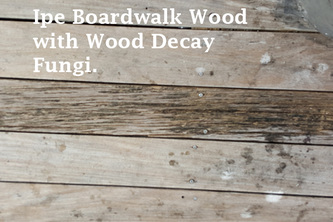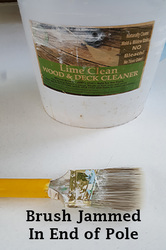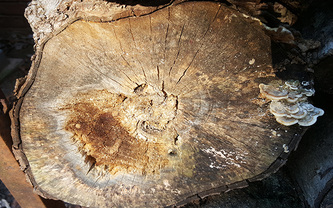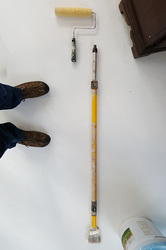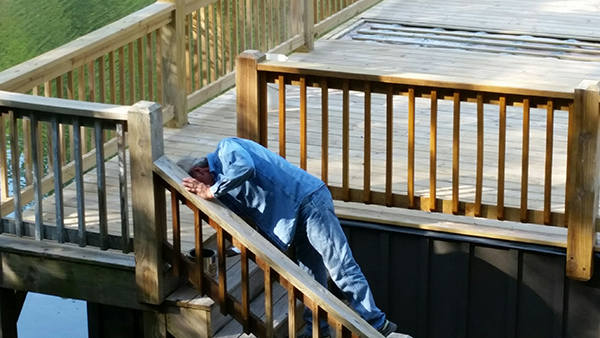THE BEST WAY TO CLEAN AND PREP A DECK
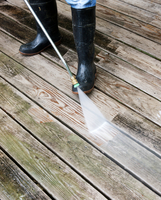
The best way to begin
staining a deck is with proper deck cleaning and prep. If you haven't built your deck yet try to get FSC sourced wood.
Why is prep important? Because mold / mildew, mill glaze, wood extractives, algae, insects and other contaminants will harm the deck staining project. A good prep job will address all of these things.
There are a vast array of deck wood types used to build decks. This page will focus on a few of the main deck wood types and lump them into categories for the sake of simplicity. By following these simple step by step instructions, anyone should be able to clean and prep a deck to get a great deck stain.
PRESSURE TREATED DECKING: Of all the deck wood types Pressure Treated decking is the most common. Unfortunately, pressure treated wood is also low quality and pressure treated decks can be difficult to keep looking good. Pressure treated decks can be left unstained to turn grey or black without any protection and they will resist rot temporarily. The pressure treating chemicals help with this temporarily. Regardless, mold and algae often still grow on them and wood decay fungi still tends to find its way into the wood eventually. All things considered, it's best to coat a pressure treated deck when it's new if possible. You will read a million places to let pressure treated decks weather. Yes. That is easier but it is not best. It results in more splitting, warping, twisting, mold and algae growth and makes long term protection and staining more difficult.
PLAN TO COAT CLEAN AND STAIN NEW WOOD WITH A BREATHABLE COATING THE FIRST YEAR: Just like any other decking wood, PT decking does best when it is prepped properly and allowed to acclimate to its new home with a good strong deck stain on it the first year. All future coats will be easier because mold, grease and dirt were not allowed to embed into the wood fiber cell; ultimately the wood will have less problems. The wood will be breathable yet able to control the rate of escaping moisture. Not trapping moisture but controlling the emission rate. That is best. New pressure treated is usually wet with chemicals and this confuses some people. In actual practice new deck wood just needs to be dry before staining and then given ONE coat of a "breathable" stain. In real life, what this does is slow the escape of moisture and balance it out. Plan to coat all six sides of the board if possible. Coating the board ends is very important since moisture wants to escape fastest at the board ends resulting in splitting and other issues. After deck cleaning, when you coat the deck wood, make sure to coat the board ends really well. Sometimes a wax, like Looking Glass Beeswax Polish, is used on the board ends since it fills in the rough areas quickly in one pass.
PRESSURE TREATED DECK CLEANING
1. Wash with Lime Clean
2. Sand 35- 50 grit
EXOTIC HARDWOOD DECK CLEANING (IPE, MAHOGANY, GARAPA, Etc):
1. Wash with Lime Clean
2. Brighten with White Distilled Vinegar (optional)
3. Sand 35 grit floors, 50 grit top rail.
CEDAR and REDWOOD DECK CLEANING:
1. Wash with Lime Clean
2. Brighten with White Distilled Vinegar (optional)
3. Sand 35 grit floors, 50-80 grit top rail.
As you can see there are really only three main categories for deck wood types. Long lasting stain depends on proper deck cleaning and preparation. If this is skipped no deck stain will work well. The chemicals in pressure treated need to be washed off the surface. Even for new wood. The Extractives in Exotic Hardwoods, Cedar and Redwood also need to be addressed. Even in new wood. The strongest deck cleaner we have found that addresses all the issues is Lime Clean. There are a ton of other ways to clean a deck but all things considered Lime Clean helps us insure that all the bases are covered. It is more work for us. But the job is done right.
WHAT YOU MUST KNOW ABOUT MOLD and MILDEW ON DECKS: Mold and mildew must be killed before coating a deck. A common mistake is washing a deck with just a pressure washer but not addressing mold. Another common logic goes, "This wood is new. It doesn't have any mold on it." but any wood outside for more than a day is going to have some mold spores building up on it. Staining over this mold creates an atrium for mold growth. Often, we can see streaks of mold under the stain where the brush picked up lots of mold spores and spread them around. This is hard to fix. Lime Clean is almost always able to break it up but sometimes it takes two passes and a careful pressure washing and extra sanding. This ends up being more prep expense for the homeowner who could have avoided the whole issue if the deck was cleaned properly before staining.
THE LIMITATIONS OF PRESSURE WASHING AND CHEMICAL INJECTORS: Many contractors don't realize the persistence of mold. Nature wants fungi (mold) to break down wood and turn it into soil. That is the natural course of things. It's not just surface level mold. Some wood has fungi growing in the grain of the wood. Usually it grows in the sap wood, while the extractives collect more densely in the heartwood. In many cases the mold enters the wood while the tree is growing. This does not always get killed before being turned into decking. A light washing with diluted bleach sprayed out of a chemical injector on a pressure washer is not sufficient to properly address mold and mildew on decks. It is done all the time but it isn't the best way and often results in problems 6-12 months later. This often baffles contractors when they are called back to the job, scratching their heads, thinking, I know I used bleach in my chemical injector before I pressure washed. But that's not always enough. It often takes a good 30 minutes of contact to kill mold and any mold under the surface may require even longer contact. Bleach and things sprayed through chemical injectors on a pressure washer are diluted and usually blasted off shortly after application. Seldom are they applied at the strength required for deep mold penetration in wood and seldom are they left on long enough to address the mold, much less the extractives in wood. This information comes from experience. You wont read it in a book and you probably wont get this information from most contractors. I was a contractor who swore by my methods for years until I actually was shown the results and taught the basic science. Bottom line: Lime Clean is the only cleaner that forces me to make sure all the bases are covered when I clean a deck.
THERE ARE MANY WAYS TO MANAGE MOLD ON A DECK
Lime Clean works the best. Oxalic Acid is second best but can be difficult to use properly and does a poor job of addressing the extractives. Trisodium Phosphate can be made into a strong solution that is effective against mold and mill glaze but it has ecological concerns, particularly for the harm that phosphates do to earth’s water. Earth Clean is a great liquid deck cleaner and usually works better than bleach, especially over the long term. Bleach is the last option and if used we would use it straight, undiluted or diluted just a little bit. Keep in mind that liquid bleach sold to consumers is diluted sodium hypochlorite (Clorox lists 8.25% as of this writing). Applying pure bleach can brighten wood and then it will evaporate. This isn't good for the atmosphere but at least it doesn't get washed immediately into the ground or into waterways. Then the deck can be pressure washed after bleaching. This isn't the best option but it’s cheap and although bleach odor is very strong, this is a pretty cheap and easy to do option. Oxygen bleach isn't recommended since it has not been found reliable over the long term but it does brighten the wood fast with low odor.
Why is prep important? Because mold / mildew, mill glaze, wood extractives, algae, insects and other contaminants will harm the deck staining project. A good prep job will address all of these things.
There are a vast array of deck wood types used to build decks. This page will focus on a few of the main deck wood types and lump them into categories for the sake of simplicity. By following these simple step by step instructions, anyone should be able to clean and prep a deck to get a great deck stain.
PRESSURE TREATED DECKING: Of all the deck wood types Pressure Treated decking is the most common. Unfortunately, pressure treated wood is also low quality and pressure treated decks can be difficult to keep looking good. Pressure treated decks can be left unstained to turn grey or black without any protection and they will resist rot temporarily. The pressure treating chemicals help with this temporarily. Regardless, mold and algae often still grow on them and wood decay fungi still tends to find its way into the wood eventually. All things considered, it's best to coat a pressure treated deck when it's new if possible. You will read a million places to let pressure treated decks weather. Yes. That is easier but it is not best. It results in more splitting, warping, twisting, mold and algae growth and makes long term protection and staining more difficult.
PLAN TO COAT CLEAN AND STAIN NEW WOOD WITH A BREATHABLE COATING THE FIRST YEAR: Just like any other decking wood, PT decking does best when it is prepped properly and allowed to acclimate to its new home with a good strong deck stain on it the first year. All future coats will be easier because mold, grease and dirt were not allowed to embed into the wood fiber cell; ultimately the wood will have less problems. The wood will be breathable yet able to control the rate of escaping moisture. Not trapping moisture but controlling the emission rate. That is best. New pressure treated is usually wet with chemicals and this confuses some people. In actual practice new deck wood just needs to be dry before staining and then given ONE coat of a "breathable" stain. In real life, what this does is slow the escape of moisture and balance it out. Plan to coat all six sides of the board if possible. Coating the board ends is very important since moisture wants to escape fastest at the board ends resulting in splitting and other issues. After deck cleaning, when you coat the deck wood, make sure to coat the board ends really well. Sometimes a wax, like Looking Glass Beeswax Polish, is used on the board ends since it fills in the rough areas quickly in one pass.
PRESSURE TREATED DECK CLEANING
1. Wash with Lime Clean
2. Sand 35- 50 grit
EXOTIC HARDWOOD DECK CLEANING (IPE, MAHOGANY, GARAPA, Etc):
1. Wash with Lime Clean
2. Brighten with White Distilled Vinegar (optional)
3. Sand 35 grit floors, 50 grit top rail.
CEDAR and REDWOOD DECK CLEANING:
1. Wash with Lime Clean
2. Brighten with White Distilled Vinegar (optional)
3. Sand 35 grit floors, 50-80 grit top rail.
As you can see there are really only three main categories for deck wood types. Long lasting stain depends on proper deck cleaning and preparation. If this is skipped no deck stain will work well. The chemicals in pressure treated need to be washed off the surface. Even for new wood. The Extractives in Exotic Hardwoods, Cedar and Redwood also need to be addressed. Even in new wood. The strongest deck cleaner we have found that addresses all the issues is Lime Clean. There are a ton of other ways to clean a deck but all things considered Lime Clean helps us insure that all the bases are covered. It is more work for us. But the job is done right.
WHAT YOU MUST KNOW ABOUT MOLD and MILDEW ON DECKS: Mold and mildew must be killed before coating a deck. A common mistake is washing a deck with just a pressure washer but not addressing mold. Another common logic goes, "This wood is new. It doesn't have any mold on it." but any wood outside for more than a day is going to have some mold spores building up on it. Staining over this mold creates an atrium for mold growth. Often, we can see streaks of mold under the stain where the brush picked up lots of mold spores and spread them around. This is hard to fix. Lime Clean is almost always able to break it up but sometimes it takes two passes and a careful pressure washing and extra sanding. This ends up being more prep expense for the homeowner who could have avoided the whole issue if the deck was cleaned properly before staining.
THE LIMITATIONS OF PRESSURE WASHING AND CHEMICAL INJECTORS: Many contractors don't realize the persistence of mold. Nature wants fungi (mold) to break down wood and turn it into soil. That is the natural course of things. It's not just surface level mold. Some wood has fungi growing in the grain of the wood. Usually it grows in the sap wood, while the extractives collect more densely in the heartwood. In many cases the mold enters the wood while the tree is growing. This does not always get killed before being turned into decking. A light washing with diluted bleach sprayed out of a chemical injector on a pressure washer is not sufficient to properly address mold and mildew on decks. It is done all the time but it isn't the best way and often results in problems 6-12 months later. This often baffles contractors when they are called back to the job, scratching their heads, thinking, I know I used bleach in my chemical injector before I pressure washed. But that's not always enough. It often takes a good 30 minutes of contact to kill mold and any mold under the surface may require even longer contact. Bleach and things sprayed through chemical injectors on a pressure washer are diluted and usually blasted off shortly after application. Seldom are they applied at the strength required for deep mold penetration in wood and seldom are they left on long enough to address the mold, much less the extractives in wood. This information comes from experience. You wont read it in a book and you probably wont get this information from most contractors. I was a contractor who swore by my methods for years until I actually was shown the results and taught the basic science. Bottom line: Lime Clean is the only cleaner that forces me to make sure all the bases are covered when I clean a deck.
THERE ARE MANY WAYS TO MANAGE MOLD ON A DECK
Lime Clean works the best. Oxalic Acid is second best but can be difficult to use properly and does a poor job of addressing the extractives. Trisodium Phosphate can be made into a strong solution that is effective against mold and mill glaze but it has ecological concerns, particularly for the harm that phosphates do to earth’s water. Earth Clean is a great liquid deck cleaner and usually works better than bleach, especially over the long term. Bleach is the last option and if used we would use it straight, undiluted or diluted just a little bit. Keep in mind that liquid bleach sold to consumers is diluted sodium hypochlorite (Clorox lists 8.25% as of this writing). Applying pure bleach can brighten wood and then it will evaporate. This isn't good for the atmosphere but at least it doesn't get washed immediately into the ground or into waterways. Then the deck can be pressure washed after bleaching. This isn't the best option but it’s cheap and although bleach odor is very strong, this is a pretty cheap and easy to do option. Oxygen bleach isn't recommended since it has not been found reliable over the long term but it does brighten the wood fast with low odor.

